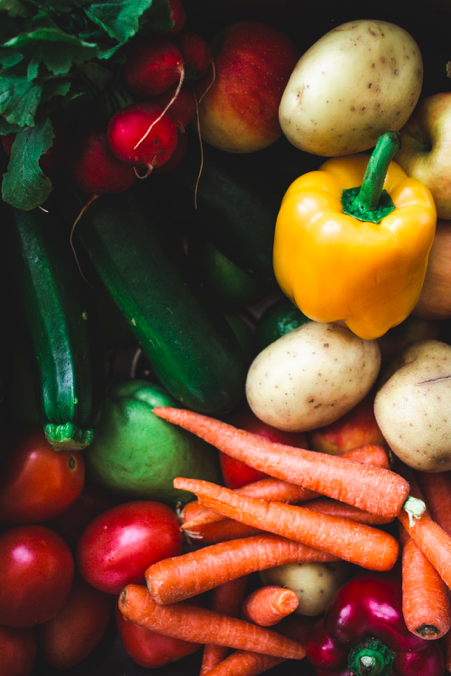Getting Enough Variety of Food
Everyone has personal food likes and dislikes. For some people, a dislike of a lot of foods can make it hard to get enough variety in their diet for good health, and can make social eating difficult. This can arise for a number of understandable reasons. You may have a lifelong high sensitivity to particular flavours, odours and textures, so you may experience ordinary foods as unpleasant or even disgusting. Food aversions may begin with a distressing experience such as choking, or an illness with persistent or severe nausea and vomiting. It may also arise if your childhood experience of food was often upsetting because adults tried to get you to eat foods you couldn’t tolerate, or you have other distressing associations with food. If it is very extreme, causing severe symptoms such as choking, gagging or panic; or limiting the number of acceptable foods to fewer than fifteen, this may be a disorder called Avoidant-Restrictive Food Intake Disorder (ARFID), which needs specialist treatment. If you think you may suffer from ARFID, seek help from your GP or therapist.
Even if food your faddiness is not so severe, it may be enough to impair good health and nutrition, keep you below your healthy weight, and interfere with joining comfortably in eating with family and friends. It’s easy to wonder why people seem to care so much what you eat, and why they get impatient and exasperated about it. They may be worried about your long-term health, or upset that you can’t join social eating. Food is an important part of family and social life, and there are often foods that are shared as a valued tradition in social and religious events. People may put time, effort and skill into preparing food as a gift, or to offer hospitality, and may feel disappointed if you refuse it. You may feel uncomfortable yourself if you need separate, different food, and this creates work to prepare it for you. Some of these reasons may make it worth some effort to increase the variety of foods you can eat.
Although the taste, texture and smell of the food may be important elements in putting you off a food, anxiety is usually also part of the difficulty. For example, you will naturally feel nervous about trying a food if you think that you may find disgusting, or if you fear it may make you feel you might choke. Most people lose their appetite when they are anxious, and you may have very severe and persistent anxiety about eating if you have had distressing experiences associated with a food, or have extreme worries about your weight. It is therefore worth learning and using anxiety management strategies, and relaxation and calming techniques, to prevent anxiety stopping you trying new foods, and getting comfortable with them.
If you are relying on a small range of foods, especially if there are some whole food groups missing, or nearly missing from your diet, a daily multi-vitamin and mineral will help protect your nutrition while you work to improve the variety of foods you eat.
Working to Increase Variety
If you would like to try foods you have avoided, take some time to plan first. Think about:

Getting Help
You may want or need to work on this when you are alone, at least for some stages of the process. Or, you may find that encouragement and support is very helpful, so try to get some help at least with some of your efforts. If you live in a household where other people take part in food shopping and cooking, you may need them to help with getting the foods you need. You might want to prepare your own food, so plan together with other people who use the kitchen. If there are people that you usually eat with, talk to them about what you are trying to do, and what would be helpful, and what would be unhelpful. You may find it easier to write this down before you ask. The sort of help you need may well change as you progress, so keep your helpers informed.
Reasons to Widen Food Variety
There may be quite a mixture of reasons to increase the mix of foods you can comfortably eat. You, and others, may be concerned about general health and nutrition for the long term, if you find it difficult to maintain a steady, healthy weight, or you may be aware you need to put right a particular nutritional deficiency such as anaemia, and prevent it recurring. You might want to join more easily with everyday social eating, or eating at special occasions. You might want to be able to use eating facilities at places such as college or work, or when you are travelling or away from home. You may want to reduce the work and inconvenience of preparing special food. You might be concerned about food waste. Maybe you just want to feel less anxious and distressed about eating.
Try making a list of your personal reasons for wanting to work on this. Use it to help plan the changes you want to make, and to track your progress.
Deciding which Foods to Try, and which to Try First
Start with making a list of foods in three columns. In the first column, put foods you can eat comfortably – the “acceptables”. In the middle column, put any foods you can eat if you really have to, perhaps if there is a bit of social pressure – the “possibles”. Also, put in foods which you have eaten if the past, but no longer eat. In the last column, put foods that would be really distressing and impossible for now. Spend a few days adding to these lists, and making sure each food is in the right place.
Try to make a list of a few foods you would like to be able to eat. If you are concerned about nutrition, check that you have at least a few foods from each of the five food groups. If there are food groups you tend to avoid, see if you can include some items from these groups. Try to put them in order from the easiest to the hardest. Try not to dismiss them all as equally impossible. There may be foods that would make social eating easier. Start with one that is in your “possible” list.
Look at the list of foods you can eat, and see what the similarities are. Do they mostly have a smooth texture, or become smooth quickly in your mouth? Do they have particular flavours such as sweet or salty, or are they bland in flavour? Are they similar colours? When you have identified the features that make foods acceptable, look in your list of “possibles” to find ones that are similar. For instance, if you are OK with mashed potato, would mashed sweet potato or carrots be good ones to try? You could start with a little mixed into your safe food if that would help.

Beginning Work
Once you have decided on a food, you need to get very familiar with it, so have it around at most meals. At this stage, don’t try to eat it at all. Do as much as you can to get used to it, without thinking about eating it. Go to the supermarket to buy it, put it in your basket or trolley, and pack it into your bag. Keep some in your fridge or cupboard, handle it in the kitchen, prepare it for eating, clear away the waste.
Then, begin with thinking about what you can tolerate while you are eating. Take some steps to get more comfortable with having the food around at your mealtime, with no expectation that you will put it in your mouth at first. You might need to begin with just having some of the food in the room while you are eating your normal meal, or maybe on a separate plate on the table. When that is OK, try have a little of the food beside your own meal, then on your own plate. You don’t have to eat it at this stage. When it is comfortable to have the food on your plate, try getting a bit more familiar. You might want to check how it smells, or feels to the touch. You might want to touch or squeeze it with your fingers, touch it to your face or lips. If you can get comfortable with the feel of the food on your lips, try it in your mouth. Hold a piece of the food in your fingers or on a fork, and touch it on your tongue, for just as long as you are comfortable. When you are ready, try chewing it. Make sure you are in a situation where it is OK to spit out the food if you want to, and have a napkin ready, and a damp cloth to wipe your fingers or face. If you can get to this point, you are ready to try swallowing a small piece, in your own time. Have some chilled water, and a food you like, so you can quickly have some of that after the new food, so the new taste does not linger in your mouth.
It may help to think about how you present the food. If smell is a problem, chilled food may be easier at first. If texture is difficult, try blending or mashing. You can mask taste with a food you like. For savoury foods, you could use grated cheese, cheese sauce, salad dressing, ketchup or vinegar, or for sweet foods sugar, custard, yoghurt or honey. When you are used to this, you can try the food plain.
If you eat with other people, and they like foods you can’t eat, you can save work by preparing batches of foods you like, and freezing single portions. You can heat up a portion for your won meal, when others eat something different

Here are some ideas for foods from each group
When you are thinking about foods to try, you may be more comfortable starting with ones that are smooth in texture and fairly bland in flavour, so here are a few suggestions.
Fruit and Vegetables
If you dislike fruit and vegetables, some foods from this group would be a good place to begin work on increasing variety. If texture is a problem, you may find you are able to have juice regularly. Try using cooked or tinned fruit, made into a puree in a blender. You can eat fruit puree as a regular dessert with custard or yogurt if you like those foods. You can make fruit or vegetable smoothies in the same way, and take one as part of your breakfast. Vegetable soup can be blended to make the texture smooth. You can mash or blend root vegetables to make a smooth puree, and adjust the flavour by adding grated cheese, olive oil, yogurt or other foods that you like. If odour is off-putting, chilled juice, fruit or salad may be easier than cooked vegetables. You may find it easier to try more fruit, vegetables or salad if you serve them on a separate plate. If food faddiness is a significant difficulty for you, it may be helpful to work on this with an occupational therapist to increase the variety of foods you are able to eat.
Starchy Staples
If some starchy foods have textures you dislike, try bread sticks, crackers or crispbread; smooth creamed potato or sweet potato. If you struggle to eat enough high fibre cereals such as wholegrain bread, you can increase your fibre intake by having a tablespoon of linseeds daily, and thinking of it as regular medicine. You can add them to a smoothie, sprinkle on salad, cereal or fruit. This may be especially helpful if you experience constipation or bloating.
Meat, Fish, Eggs, Nuts, Seeds and Pulses
You might be able to have a small amount of minced meat in a well-flavoured sauce such as Bolognese. Some liver pâtés and sausages have a very smooth texture and bland flavour, and are rich sources of iron. If beans and nuts are difficult, try hummus or smooth nut butter. You may find dishes make from beaten eggs such as omelette or scrambled egg are manageable.
Milk and Milk-Based Foods
This is often a group that is not too difficult, and foods such as milk, smooth yogurt, cottage cheese, cheese spread, cheese sauce, custard, rice pudding and porridge are fairly smooth in texture and bland in flavour.
Healthy Oils and Fats
Some people find the feel of oil is off-putting, so you may find it easier to use oils in cooked foods such as sauces, so the oil is not so obvious.
You can use this information to plan meals for yourself that you can eat regularly, to make sure you get a healthy mix of all the foods you need.
You might find these interesting too!
Welcome to Co-Produced by Peace+ Pathway. In this short intro episode, our hosts Adia, a clinician, and Lauren, a researcher, introduce themselves and the focus of the podcast.
A brief PEACE+ animation for people with ADHD and eating disorders. It explains how sensory, attention and interoceptive differences affect eating, and shares low-effort supports. Co-produced with clinicians and lived experience contributors.
On 20 May 2025, we welcomed over 250 attendees from across the UK and internationally to the fourth PEACE Pathway Conference. The day brought together clinicians, researchers, lived experience experts, and service providers to share knowledge and tools for improving care for autistic individuals with eating disorders.